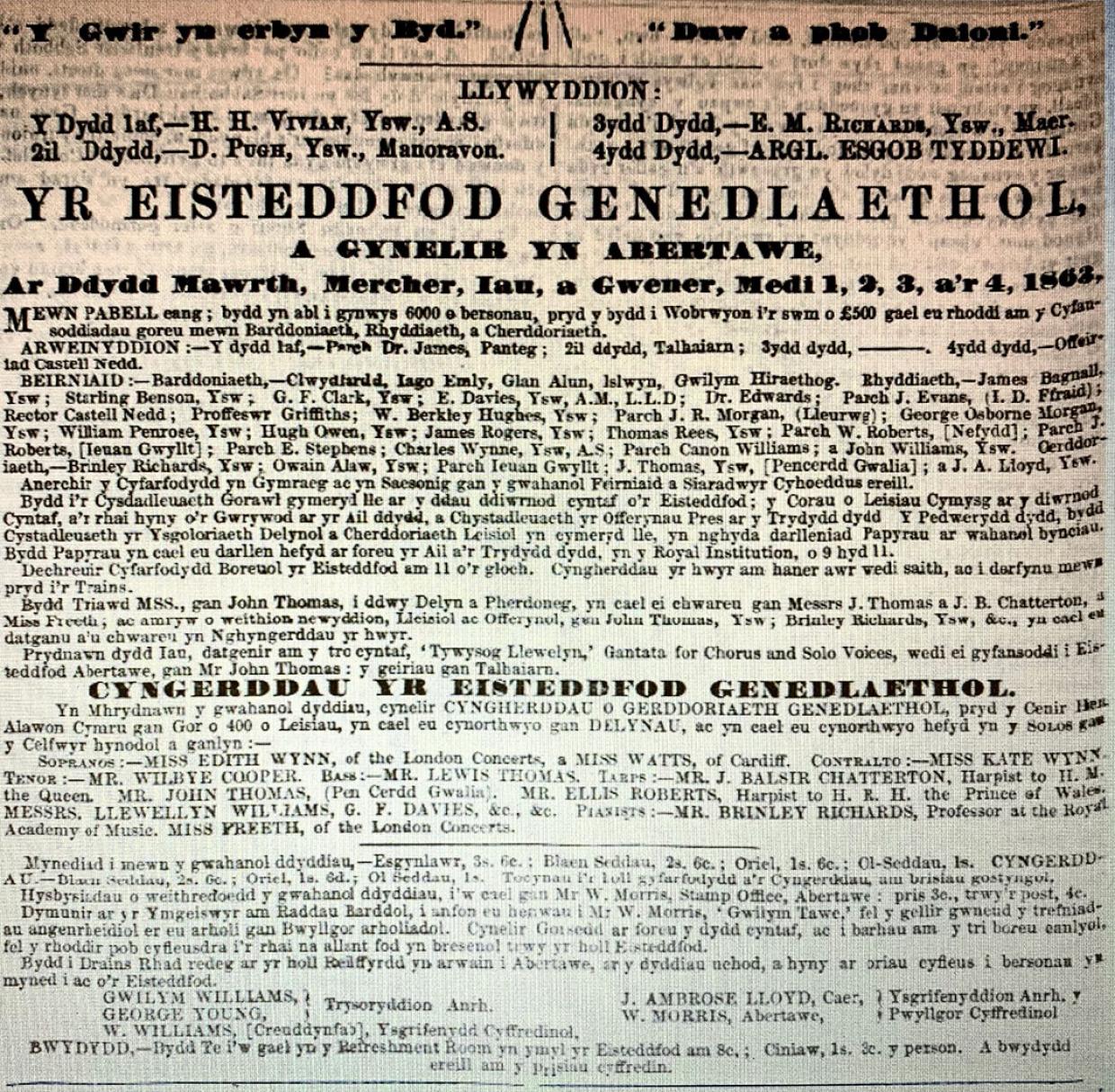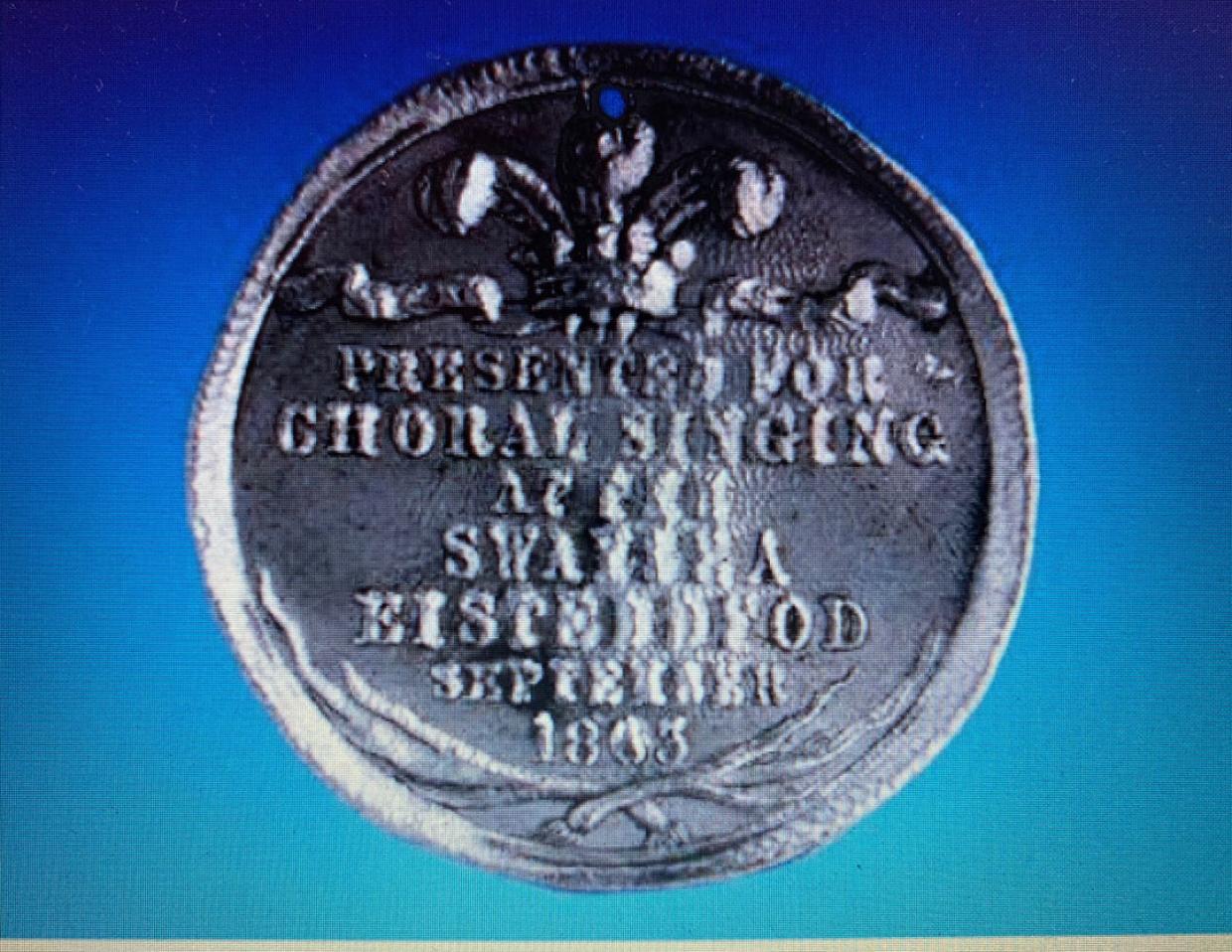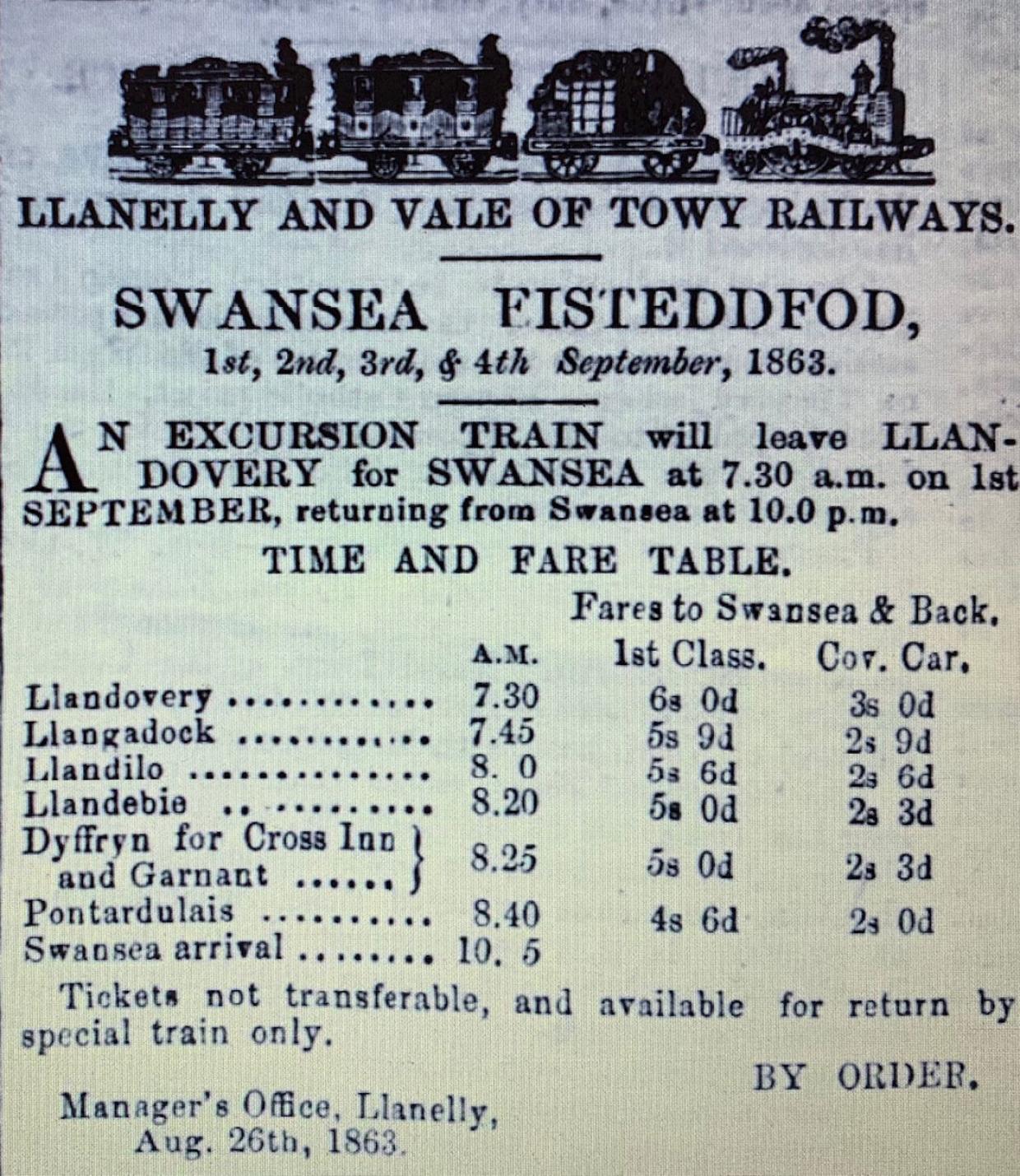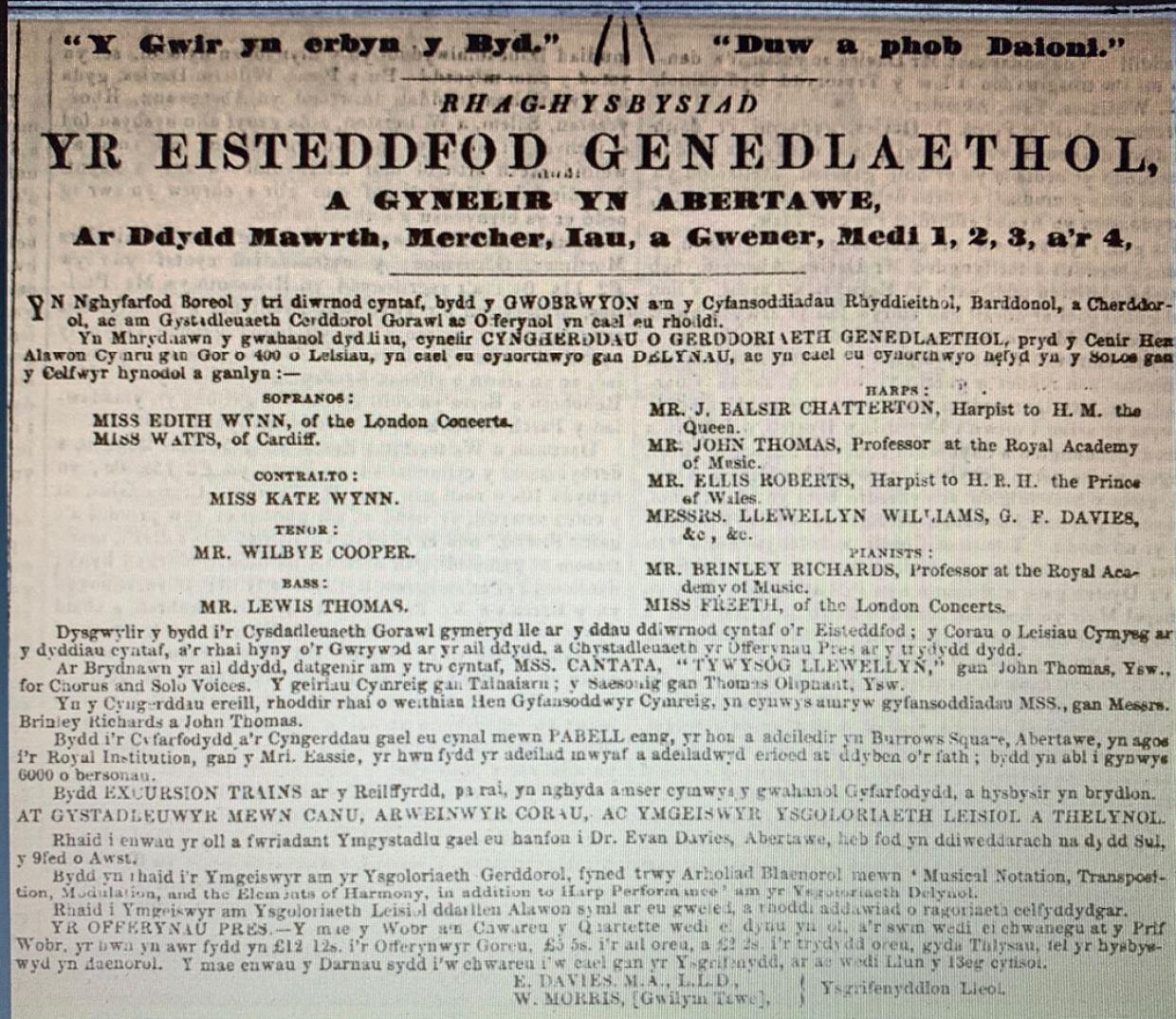But since the prestigious festival at Caernarfon Castle the previous year, the Eisteddfod had lost two of stalwarts, as noted in Y Gwladgarwr on 28 March 1863, “Last Tuesday the Swansea local committee held a meeting regarding the National Eisteddfod at the Guildhall. The meeting was well-attended and Mr Alderman Phillips was elected to the chair. After reading the notes of the last meeting, the meeting’s attention was drawn to the profound loss suffered by the Eisteddfod in the deaths of Alaw Goch and Eben Fardd. Out of respect for the commemorations of these two poets, it was decided to defer any prize for compositions on their lives and works to a future Eisteddfod, so as to allow sufficient time to compose and do justice to the subject. ”
It is worth quoting part of the tribute to Alaw Goch, which appeared in Y Gwladgarwr on 7 March 1863, "Little did he or his friends think that this fine morning, would be the final morning Alaw Goch would have in this world. He enjoyed his morning food as usual, spent most of the early part of the day in and around his house. At lunchtime he went to the table happily, full of innocent humour, until every heart was filled with happiness and a smile on every face… But Oh! this was but the bright overdose of sparks burning out. The cheerfulness, the vitality, the wit, the smartness and the ease of his best days came out in Alaw Goch last week, only for him to to die forever and leave this life.”
The loss was devastating to the National Eisteddfod, just a few years after Alaw Goch and Eben Fardd were both instrumental in creating the new national organisation. The organisers of the 1863 Eisteddfod felt deeply saddened by the loss, and believed that the poets of Wales needed a year to enable them to compose any 'official' poems in mourning eulogising two who were so prominent in Welsh culture.
But arrangements for the Eisteddfod in Swansea had to go ahead, and 1863 saw the creation of a musical scholarship as part of the festival. This is reported in Y Gwladgarwr on 15 August, " We are pleased to see the music scholarship established, - it pulls energy out and assists effectively in reaching a higher culture in the music of our country. We have a firm belief that the children of the Gwalia mountains are soon to stand tall among British singers; and if this comes to an end, everyone will remember this excitement and the help received from the Swansea Eisteddfod. We also rejoice because the arts are being featured, and especially because the published List of Competitions hold such a close connection to our happiness and our own and our families’ comforts.”
So, with a month to go until the Eisteddfod, things were shaping up and everyone was looking forward for a wonderful festival. Advertisements appeared in the press encouraging people to visit the festival on special trains, and Y Gwladgarwr was very happy to sing the praises of the preparations, saying, “The time of our big literary festival is near; and judging by the energy of the executive committee, by the number of compositions sent in, by the fame of the singers, the players, the speakers, and the adjudicators, by the prestige of the presidents, and by the noise of the country, the Swansea Eisteddfod will exceed every Eisteddfod held to date.”
And as the festival got underway, Y Gwladgarwr reported that “… all the local preparations for hosting it have been completed in full. The marquee is a great honour for the good people of Swansea. It is built, as we mentioned before, in Burrows Square and capable of accommodating at least six thousand persons. It is a strong building, and has been approved by the town's Health Board Officer as being fit for the purpose of its construction. The spacious tent is also superbly decorated, so that all visitors will be convinced that no cost has been spared to make it convenient and comfortable. ”
We will return to the fact that the marquee is "a strong building, and has been approved by the town's Health Board Officer as being fit for the purpose of its construction" shortly. In the meantime, the whole town was looking forward to the Eisteddfod, with Y Gwladgarwr declaring, "This morning (Tuesday) the town is vibrant - multicolored banners and evergreen branches decorating the most abundant part of the city and the roads - the bells of the Churches are ringing vigorously - and all the railways seem to bring thousands of foreign visitors. ”
On its website, Amgueddfa Cymru - National Museum Wales discusses the beginnings of the National Eisteddfod, highlighting 1863 as the start of the choral singing era, with a medal being presented to the winning choir. According to Y Gwladgarwr, there were three choirs in the competition, “At this time a prestigious choral competition took place… The top prize, £10, was won by the Aberdare Union choir, led by Mr S Evans, to which Miss Vivian presented the prize. The second prize, £5, was won by the Swansea and Morriston Union choir, and the prize was presented by Miss Williams, Llanfairynghornwy. The third prize, £2, was won by the Swansea Valley Union choir, and one of the members was presented with the award by Mrs Griffiths, Neath.”
This was the first major choral competition in Wales, and was the start of an important Eisteddfod tradition that has continued to this day. Below is a picture of the Medal presented to the winning choir.
However, we must turn to the 11 September edition of Seren Cymru read about the most exciting and unfortunate event at the Swansea Eisteddfod – after the town’s Health Board Officer had declared the tent as ‘fit for the purpose of its construction’, when Thursday evening’s concert was disturbed by an UNFORTUNATE INCIDENT:
"When everything was ready to start, and everyone had quietly settled to enjoy themselves, the audience was thrown into shock by the UNFORTUNATE INCIDENT when one of the beams under the southern gallery cracked. Fortunately, the beam was held in place by the iron rods that surrounded it, or many would have lost their lives. This caused quite a stir among the crowd, especially in the part of the tent where the accident took place. At this, in order to draw the attention of the congregation, the Mayor ordered that a trumpet was sounded, which had the effect of calming the audience. After that, the choir sang "Tywysog Gwlad y Bryniau," and Miss Edith Wynne sang, "Mae Robin yn Swil." However, the crowd got upset, as they felt uneasy about their safety; and the mayor ordered everyone to disperse, advising them that their tickets would be valid the following evening; and within half an hour, the spacious building was empty. We must thank the Mayor for the way in which he composed himself under the circumstances, and the crowd for dispersing so quickly. The executive committee came together to discuss the matter and the roof was restored by the following morning.”
More details, and a slightly less Eisteddfod-biased report can be found in the Monmouthsire Merlin on 12 September, “The concert on Thursday evening, was abruptly brought to a termination by some rafters, &c., giving way in the western gallery, causing much alarm, and the rush to the doors was terrific. Several persons were knocked down and slightly injured, but fortunately, no serious accident occurred. The cause of the accident was the overcrowding of the building, there being at least a thousand more admitted than the pavilion was calculated to seat comfortably. The damage was repaired by the contractors during the night.”
But, both reports state that the roof was fixed, and that the Eisteddfod was able to carry on the following morning. Seren Cymru brings the reports on the festival to a close by reporting, “…the proceedings of the National Eisteddfod of 1863 were brought to a close, and it will undoubtedly be remembered for a long time to come by the thousands who attended the festival. With the exception of the accident on Thursday night, it all passed successfully; and we believe that the National Eisteddfod is now firmly established on a secure foundation. ”




